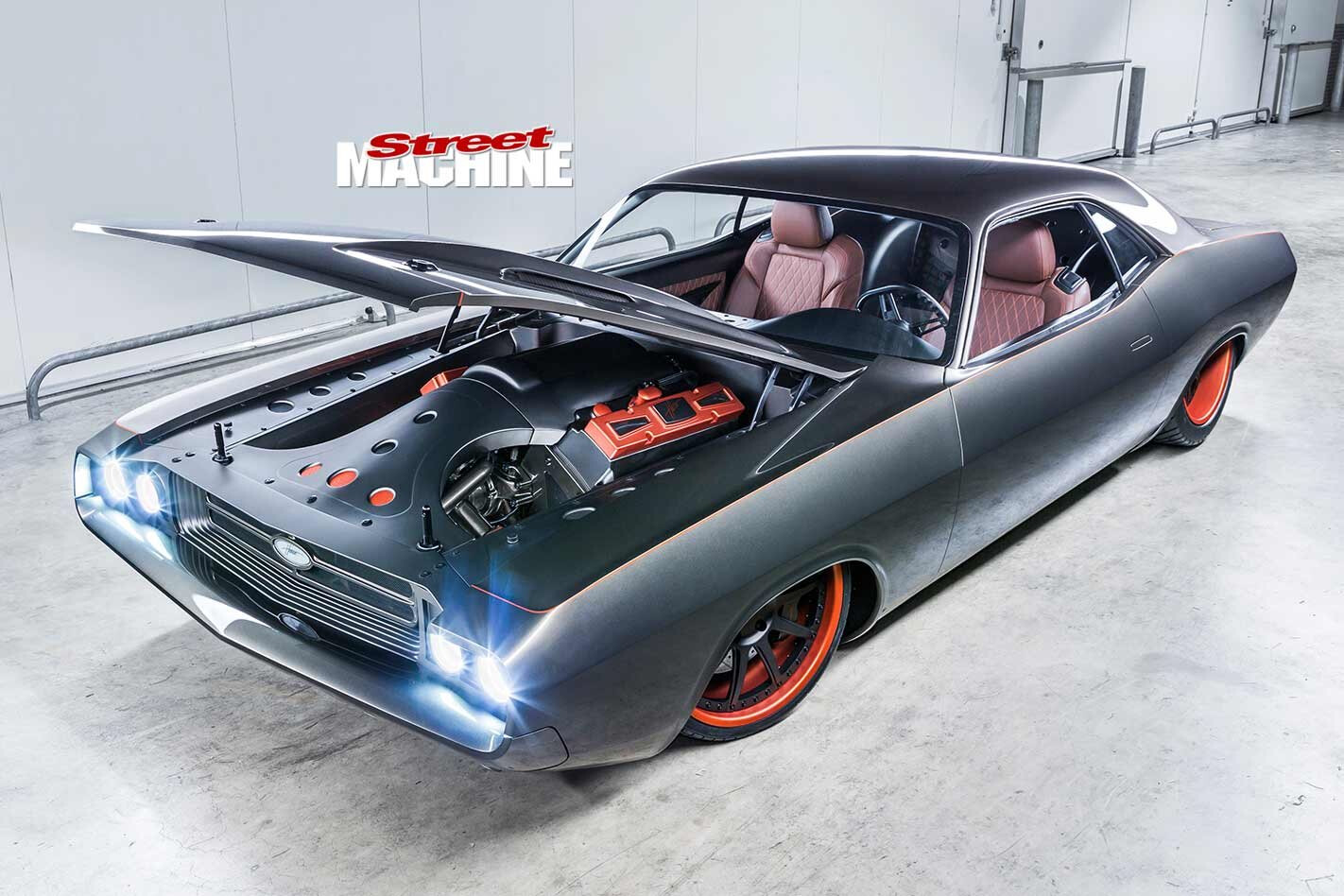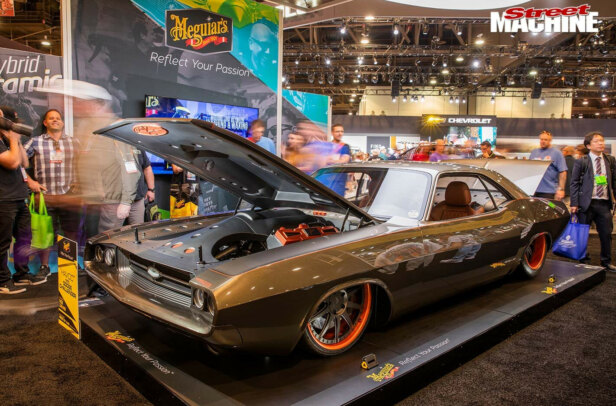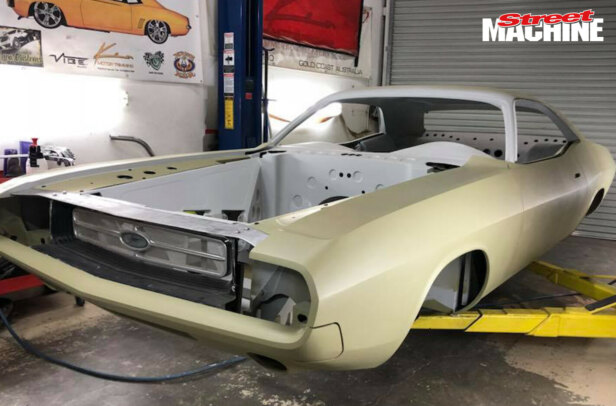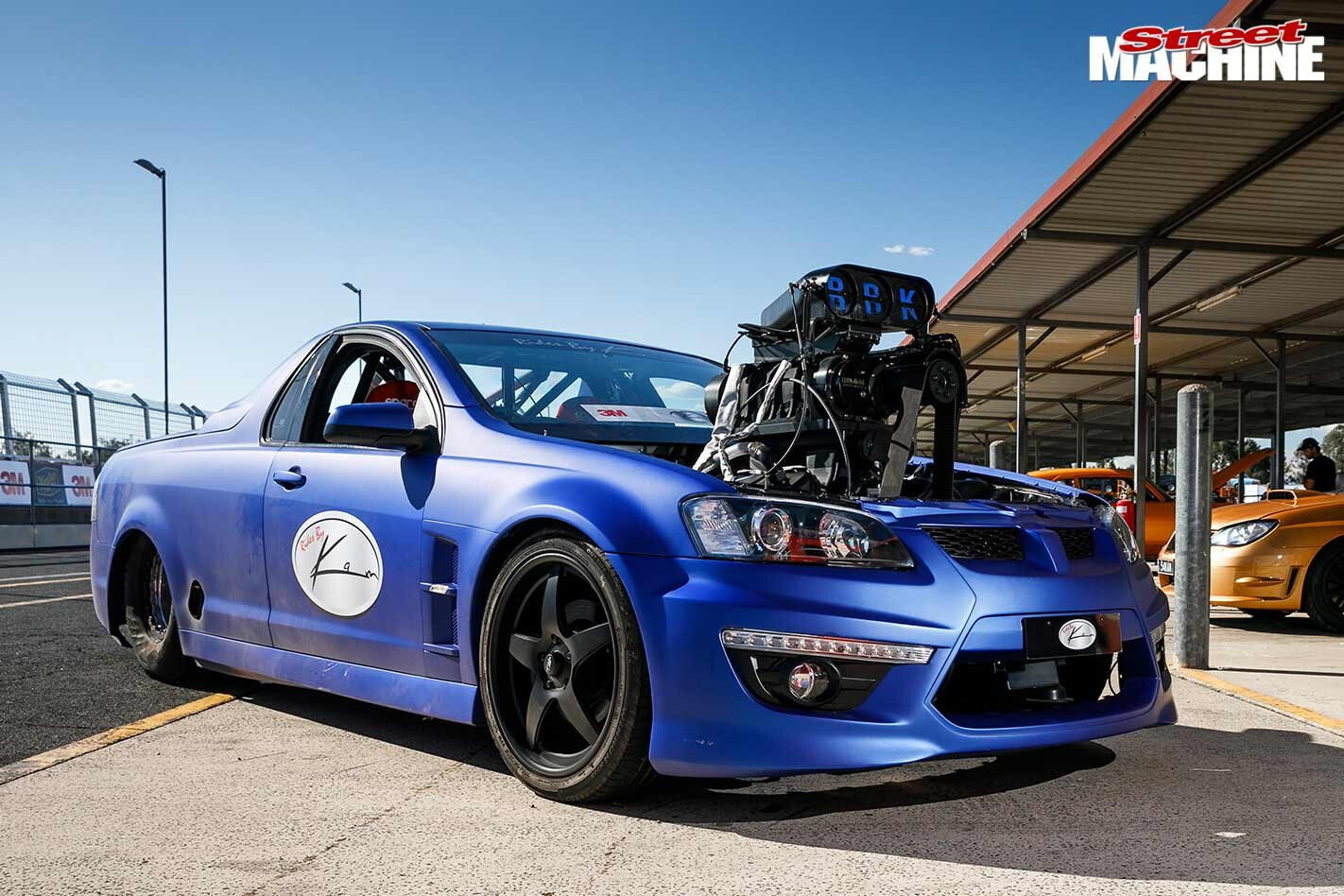HAVING created quite a buzz in the USA with his previous two builds – KAMARO (SM, Sep ’10) and KAM NOVA (SM, Nov ’14) – Rob Zahabi of Rides By Kam wanted to go next-level with his new build.
This article was first published in the January 2020 issue of Street Machine
The one-off grille, headlight assemblies, bonnet bulge and Camaro driving lights in a custom-made valance are all RBK-designed. To get the bumpers completely flush, they were narrowed and recessed back into the body
“My Camaro and Nova attracted plenty of attention in the US,” Rob says, “but judging-wise they were never in outright contention. Competing against the big guns in the US taught me that you get points for custom one-off stuff. The harder something is to do, the more they reward you. Using off-the-shelf stuff costs you points.”
The one-off Roadster Shop chassis features a double A-arm front (based around C6 Corvette uprights) with a NASCAR-spec power rack. In the rear is a narrower version of The Roadster Shop’s Fast Track IRS. Billet ShockWaves at each corner drop HAVOC flat on the deck
All of which made the build strategy for this incredible 1970 Dodge Challenger very clear: change as much as possible, custom-make as much as possible, and limit the use of ready-to-go stuff.
Even touring the US with KAM NOVA, Rob was already planning this build, with scouts out looking for a suitable donor.
As fate would have it, a clean 1970 Challenger popped up just days after KAM NOVA sold at auction at Barrett-Jackson Scottsdale for a spectacular US$220,000. Time to go shopping!
Myriad parts were secured and shipped in the same container with the car back to Australia. Once the Challenger was nestled safely at Rides By Kam’s Gold Coast HQ, the design phase started in earnest. “I like to draw everything out,” Rob says. “It helps me visualise how it will look.”
Along with the American Legend Blackhawk wheels, the six-piston Baer calipers were engraved with HAVOC logos
Once the design was defined, the Challenger was welded to a rigid frame and fully braced to keep everything square while it was completely gutted. “There was nothing left. It was like the shell of a remote-control car!”
New inner sills were cut from 3mm plate and welded into place. This had to be done very precisely, as these reinforcing plates serve as the main attachment to the new Roadster Shop chassis – it’s now all one piece.
Note the significantly set-back engine location, along with the custom billet coil covers, which bolt directly atop the original Hemi rocker covers to hide the plug leads. The blower is driven straight off the crank
“From the outset, I wanted IRS,” Rob says. “I told The Roadster Shop it needed to handle 2000hp and how wide it needed to be. They custom-made the whole thing for us. It fit millimetre-perfect when we slid it into place – they did a great job.”
Rob is adamant that the key to wins like that is cubic hours planning out all the tricky stuff from day one.
The all-new hipline is a case in point. Preferring the sharp, chiselled lines of his 2015 Dodge Challenger, Rob decided to slice his ’70 Challenger from tip to stern before painstakingly hand-making and welding in new filler pieces to form a completely new hipline.
To unclutter the nose area, the original pressed mouldings around the headlights and across the front of the bonnet were recreated in steel.
“I designed the billet grille, headlight surrounds and tail-lights, then had them machined from solid billet. I just sent them a few hand drawings and they went from there.
“The headlight surrounds are actually the second set, as I didn’t like my first design. They incorporate the projector lamps out of the current-model Dodge Demon. I wanted the car to look as if it was built today, which is why I incorporated the current-style hipline and projector lamps.”
This obsession with modifying everything possible even extended to the American Legend Blackhawk wheels. These three-piece, forged-billet beauties were completely dismantled, painted, reassembled and fitted with custom-engraved centre caps.
You’ll note the HAVOC logo is present throughout the vehicle, with many of the logos illuminated via LED back-lighting.
Oddly, HAVOC’s overall colour scheme was essentially determined by the wheels. “I wanted orange hoops. It’s the same burnt orange as Miranda Built used on Steve Tornari’s ’67 Nova – they even gave me the paint code!”
Every single component that bolts on, whether that be the engine, driveline or suspension, is finished in gloss, which has then been wet-rubbed and buffed
Those orange rims subsequently locked in the colour of the engine bay accents, pinstriping, instrument lighting and interior leather. Flow and continuity are ultra-important in this build.
Despite Rob’s many years as a high-end motor trimmer (he trimmed Street Machine’s Southern Comfort Cruiser giveaway car, for example), HAVOC’s interior was the biggest challenge of all. That’s because it’s mostly fabricated from steel, broken only by a few diamond-stitched leather inserts.
“The hoodlining is all one piece that flows down into the sides and wheel tubs,” Rob explains. “It was very tough – welding upside down, sparks falling in your face, your head getting burnt.”
Unlike a normal interior, with HAVOC being mostly steel there was nowhere to hide anything. Then there were all the interior panels – stuff like the rear tubs, front and rear firewall, and the sections of the floor that can be seen from both sides. Each side had to as perfect as the other. Apparently it was a nightmare!
The all-metal dash started as nothing more than curved bits of rod hanging in free space and was then slowly filled in, then adorned with a Dakota Digital dash. As well as the Ridetech airbags, the iPad also controls the interior lighting and stereo – it even receives Rob’s emails and messages!
With HAVOC’s belly-scraping ride height, both the engine and rear end had to be raised up quite high, which in turn made for a mega-tall tunnel. So Andy from Rides By Kam came up with the novel idea of running the tailshaft through a floating tube – there’s a gap underneath it to the floor. As cool as this is, it made mounting the tailshaft a real challenge. The panelwork and truss structure immediately behind the front seats unbolt, which allowed the tailshaft to sit inside the floating tube and the entire structure then bolted back into place. Very trick indeed.
When it comes to HAVOC’s exterior, it’s easier to point out what hasn’t been modified: the centre of the turret – that’s it! Everything else has been smoothed, tucked and sharpened. While it’s still obviously a ’70 Dodge Challenger, it almost looks like it’s carved from one solid block.
The glass is all brand-new factory stuff, around which the rest of the car was built. The body contours had to be altered in a number of areas to suit the curvature of the glass, as normally the chrome moulds hide their differing shapes.
The 572-cube Hemi was another piece built before the car left the US.
“Through modifying my 2015 Challenger, I’d made a number of connections at The Mopar Shop,” Rob says. “I contacted them about building me a big-cube Hemi. Jake from Jake’s Performance gave them all the necessary specs, and Stanton Racing Engines (the same guys who build Mopar’s NASCAR engines) built it specially for us.”
Only a few minor things needed to be changed to accommodate the crank-driven F3 ProCharger, which Jake added Down Under.
“Our goal was to build a car that’s great to drive, so we didn’t compromise on the functionality or engineering side of things for the sake of looks – all of which took a lot of figuring out. This is why we only aimed for around 1500hp, even though it came out a bit better than that.”
The F3 is good for 2500hp, so it’s barely breaking a sweat. And, despite the engine being well back, finding enough space for the twin PWR radiators (each with twin SPAL fans) and PWR intercooler was still a head-scratcher.
As well as looking hell-cool, the dimples punched into many of the panels serve a secondary purpose, giving the panels rigidity to hold their shape
Those familiar with KAMARO and KAM NOVA will note the recurring supercharger theme. “I love the instant power of them,” Rob says, “which we teamed up with EFI.”
After mocking-up the custom intake using cardboard, Rob dragged out his TIG to make the real one out of rolled, bent and folded aluminium. It incorporates a gaping 120mm throttlebody and monstrous 2200cc injectors.
To make it all happily run on pump fuel, Jake tuned it to perfection via a Link G4 ECU.
Note the lack of rubber coolant hoses too; instead they’re all made from rigid pipe connected by high-end Wiggins clamps. They’re the same featherweight beauties the V8 Supercars brigade use, and they cost a couple of hundred bucks each! With no flexible hoses, there was no room for error; every pipe had to line up and fit together perfectly.
“The Yanks love stick-shift cars, so that’s what we gave them,” Rob says. “Mopar stuff can be a bit tricky; here again The Mopar Shop organised the high-horsepower T56 Magnum gearbox and Quick Time bellhousing.”
Despite the massive amount of fabrication and detailing, HAVOC was built in a bit over three years, with Rob estimating it consumed around 10,000 hours.
“The only time it left our shop was to go to CAD Custom in Melbourne. We did all the fabrication, wiring, mechanical stuff and bodywork in our shop, including spline-finishing every panel, plus painting all the interior, engine bay and underbody matte clear. Along with all the driveline and hundreds of bolt-on parts.
“I got Carmine to lay on the PPG Charley Hutton Slanted Brown to the exterior shell, as I needed a break from the car. When it came back, the RBK crew were fresh for the final push to make The Great Meguiar’s Uncover at Summernats 32.” HAVOC won a host of awards there, including Top Judged Elite.
Despite the bulk time spent on building HAVOC, it was done primarily after hours.
“We were still working regular shop hours, still doing customer cars,” Rob explains. “Every morning, every afternoon, every weekend.
“Still, I wouldn’t have been able to do it without massive help from my sons, Mitchell, Cooper and Tyler, along with Andrew Maybury and Craig Bulmer. Plus, of course, my wife Tricia for being so supportive of my automotive passion. And I can’t forget the public for backing our builds.”
VIVA LAS VEGAS!
HAVOC was a massive hit at SEMA 2019 in Las Vegas. Having been invited to be the showcase vehicle on the Meguiar’s stand, it drew plenty of attention and accolades.
It made the Battle Of The Builders final 15 in its category, was a Goodguys Gold Award finalist and a Best On Roadster Shop finalist, and Baer Brakes gave it the SEMA Show Stopper Award. Baer only gives out one award at SEMA, and despite HAVOC’s brake calipers being minus the Baer logo and there being hundreds of other mental Baer-equipped cars to choose from, the company still chose the Challenger – it made that big an impact on them!
ROB ZAHABI
1970 DODGE CHALLENGER
Paint: PPG Charley Hutton Slanted Brown
ENGINE
Brand: 572 Dodge Hemi
Induction: Rides By Kam
Blower: F3 ProCharger
Heads: Mopar
Throttlebody: 120mm
ECU: Link G4
Injectors: 2200cc
Camshaft: Mopar
Lifters: Mopar
Pistons: Diamond 10.0:1 forged
Crank: Scat 4240 forged
Oil pump: Milodon high-volume
Fuel system: Walbro 460 (x3)
Cooling: PWR radiator, SPAL fans
Exhaust: 2in headers, 4.5in system
Ignition: ICE
DRIVELINE
Gearbox: Magnum T56 six-speed
Clutch: Twin-plate ceramic
Diff: Roadster Shop 9in
Tailshaft: 1350 unis with Strange yoke
CHASSIS & BRAKES
Front: Roadster Shop double A-arm, billet ShockWaves
Rear: Roadster Shop IRS, billet ShockWaves
Steering rack: NASCAR power rack-and-pinion
Brakes: Baer six-piston calipers, 15in rotors (f & r)
Master cylinder: Wilwood
INTERIOR
Seats: VF Commodore
Trim: Mostly painted steel
Steering wheel: Billet Specialties
Instruments: Dakota Digital
Shifter: Ringbrothers
Tunes: Fusion and Pioneer
WHEELS & TYRES
Rims: American Legend Blackhawk; 20×8 (f), 20×15 (r)
Rubber: Kumho 225/30R20 (f), M/T SR 31x18x20 (r)
THANKS
3M (body prep materials); PPG (paint); PWR (coolers); Meguiar’s (polishing/detailing products); American Legend Wheels; The Roadster Shop; Dave Kindig; Scott’s Hotrods; Greening Auto Company; Jack Methner (sourcing donor car); Jake’s Performance; The Mopar Shop; Ringbrothers; Ridetech; Dakota Digital; Charley Hutton; Billet Automotive Buttons




Comments